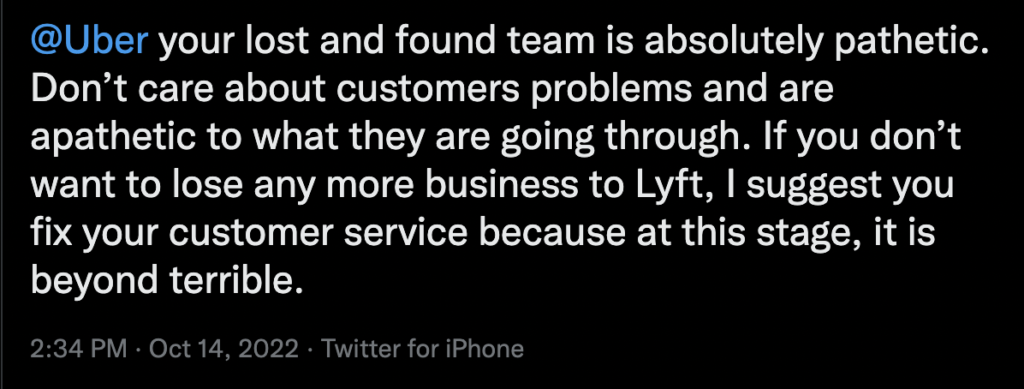You arrive at your destination, say your thank you’s, close the door, and off your chariot goes… minutes later, a jolt of anxiety pierces your heart. You just left your phone in the backseat of your ride. What happens next?
If you’re lucky, you rode with a ridesharing service with a website that can help in tracking down your driver if you borrow someone else’s phone. If you’re unlucky, you rode in a taxi, paid cash, and have no idea what the taxi company’s name is nor who’s driving around town with your phone.
Every year, tens of thousands of items are left behind by riders of ridesharing companies and taxis. What’s worse? Most of these items never make it back to their rightful owners.
When a driver finds something in their car, they’re not legally responsible to return the item to you. So as riders, it’s not very reassuring to have your item’s fate lie in the hands of a stranger’s honesty and kindness.
Fact of the matter is, rideshare Lost & Found still remains an unsolved pain point for everyone involved… that’s why Americans spend nearly $3B a year repurchasing lost items. Here’s my take on why:
Uber:
In order to submit a lost item claim with Uber, customers need to go to their website or app. Just like any large company’s customer service line, don’t expect to break through to a representative quickly. If you choose to email them, you’re at the bottom of the queue, and they’ll get back to you when they can.
Uber has an inconsistent process for riders to follow when losing an item, as some markets have a “Greenlight Hub” where drivers can drop off found items while other markets don’t. By doing this, riders are forced to physically travel to the hub to retrieve their item within 45 days before it is donated or disposed of (see all Greenlight Hubs here).
But where it gets tricky is if you’re in a city without a hub because now, you’re stuck trying to contact the driver and coordinate a pickup location and time with them.
On top of that, you’ll also be charged a $15 item recovery fee, but because your Uber driver is an independent contractor, all Lost & Found inquiries will be managed on the driver’s own time and at their own convenience (which doesn’t always match yours!).
Lyft:
Lyft riders have similar experiences –– in addition to a $15 fee, only select cities have hubs (see Lyft’s hubs here). Items at hubs are stored there for 30 days until they’re also donated or thrown away.
Like Uber, their customer support feedback loops are not as quick as you’d wish them to be when you’re stranded without your stuff.
Alto:
Alto is the newest U.S. ridesharing service to enter the market. To beat its competitors, they’ve changed their business model; drivers are actually employees, unlike Uber and Lyft’s 1099 contractors.
Alto’s process is a bit more controlled, since drivers are employees and Alto can set a process to follow. Drivers are also required to clean their car after each ride, so finding an item quickly after a ride ends is quite likely. If the driver finds the item within 10 minutes of your ride drop off, they will call you and coordinate the return logistics.
While a fee isn’t charged by Alto for retrieving an item today, I wouldn’t be surprised if this changes to mirror Uber and Lyft.
Taxi Cabs:
It’s always a hit-or-miss. If you don’t have the meter receipt or medallion number, you’re out of luck. If you successfully locate your item, you still have to make your arrangements with the driver, garage manager, and police to recover it. You would also need to know when / where you were picked up and dropped off, how much you paid, and what payment method you used.
Pro Tip: Always memorize the taxi company’s name you’re riding with by looking at the logo of the car door or the driver’s taxi credentials in the vehicle.
Feedback Loop Breakdown:
These rideshare companies are massive, so customer support cycles leave you hanging much longer than you’re comfortable with when frantically trying to locate your lost item.
For customers who’ve lost items, all you can wish from a business is that you’re notified quickly whether they have your item or not so you can plan accordingly, either to keep searching other places you were at that day or buy your replacement.
I frequently ask my rideshare drivers about lost and found. Just yesterday, I was riding in an Uber, and the driver found a hearing aid this weekend. No one has contacted him, which could have been caused by the slow communication loop to the driver or the rider refusing to go through the hassle of recovering their hearing aid.
Rideshare Lost & Found’s Hard-hitting Numbers:
In 2022, Uber alone found nearly 60,000 items in the backseat of its drivers’ cars, and drivers only return 11 items or less a year on average. Submitting a claim today feels like a blackhole, so customers tend to take their claims to social media to make sure they’re heard, just like the ones below.



In the rideshare and taxi travel category, the frustrations are more or less the same to many other industries we’re tackling. Customers have inconsistent user experiences; communication falls short; and ultimately, a company’s NPS score is dinged for it. Like the airline industry, there are now so many options of providers: lost and found can be the reason why you leave as a customer and switch over to a competitor.
Boomerang is here to help you shine in the L&F department. Let’s get partnered up!

Skyler Logsdon
CEO, Boomerang